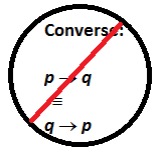Subsection 3.3.5 A Nonidentity – Converse
Notice that our last identity, the contrapositive, tells us that if we know that p implies q , then there is also a way to reason from something about q to something about p . But it’s very specific. If we know not q , then we also know not p . But what if we know q ? Can we conclude p ? In other words, can we reverse ( p → q ) and derive ( q → p )? The answer to this question is an emphatic no .

A simple real world example shows us why we’d be upset if our logic let us do that. Suppose that we have:
[1] Rain implies wet sidewalks.
Should we be certain that:
[2] Wet sidewalks imply rain.
Of course not. Maybe there’s rain. But maybe not. Someone could just have washed the sidewalks. Or someone’s sprinkler system could be on. Or the water main could have broken.
Define the converse of the expression ( p → q ) to be the expression ( q → p ). Then we have:
Converse does not follow: (( p → q ) ≡ ( q → p )) is not a tautology.
We prove this with a truth table as well:
| p | q | p → q | q → p | ( p → q ) ≡ ( q → p ) |
|---|---|---|---|---|
| T | T | T | T | T |
| T | F | F | T | F |
| F | T | T | F | F |
| F | F | T | T | T |

Notice that the final column is not all T ’s. What we see is that there are some cases where the two expressions have the same truth value. But that’s not guaranteed. There are other cases where they are different.
We’re making sort of a big deal about this one because inferring the converse is one of the most common logical errors that people make.
Exercises Exercises
Exercise Group.
1. In each of the following problems, assume [1] as a premise. Then consider [2]. Suppose that we accepted Converse as an identity (in addition to the actual identities listed above). Mark Follows if [2] would then be derivable from [1]. Mark Does Not Follow if [2] would still not follow from [1], even if Converse were an identity.
1.
a) [1] Speeding → Ticket
[2] Ticket → Speeding
2.
b) [1] Hungry ∨ LunchTime → Eat
[2] Eat → Hungry
3.
c) [1] HighMountain → Snow ∧ ¬ Trees
[2] Snow → HighMountain
